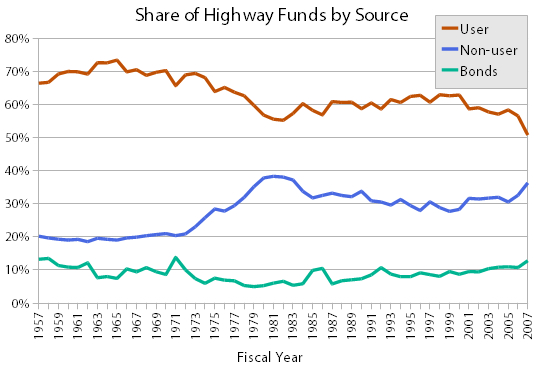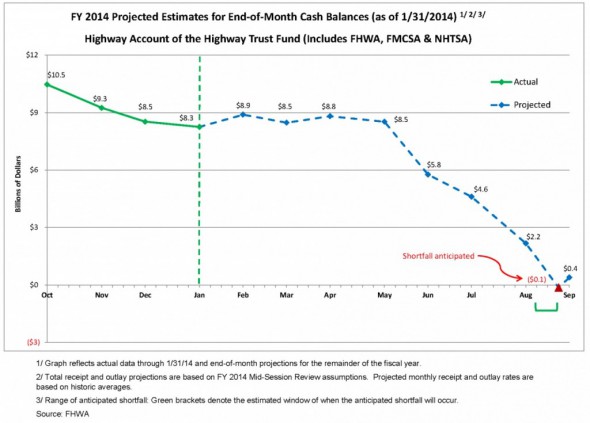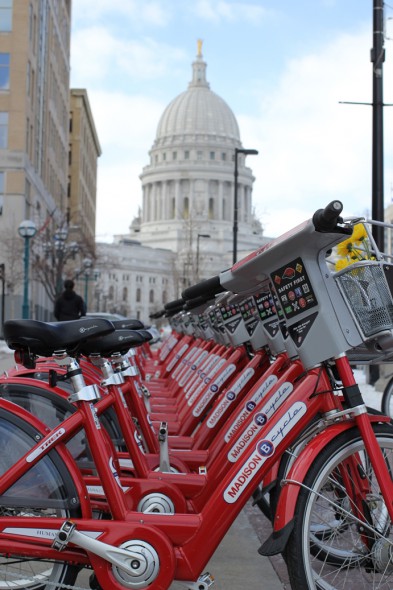Will New York’s Bike Share System Survive?
It's hugely popular and cheaper than other transit, but Mayor De Blasio opposes subsidy. Could that have ripple effect on other cities?
“At this point, city budget money is not on the table,” he said. “We will collaborate with them to help them find ways to be more efficient and more effective.”
Some might applaud the well-known progressive for drawing the line in defense of taxpayers, but given the amount of tax support for every other mode of transportation, I hope the mayor changes his mind. Citi Bike is the only bike-share system in the country that does not get any public funds. (The City of Milwaukee has provided capital funding for this city’s bike share system). Citi Bike might also be the only transportation system in the country that relies entirely on user fees and sponsorship; every other system, notably including all the roads and highways for driving but also including transit and even walking (on sidewalks, etc.) are subsidized by taxpayers.
Despite the problems with the business model, Citi Bikes has become an integral part of the way New Yorkers get around and I think it’s worth some investment of public funds to help them get over this hump. De Blasio’s decision could have a ripple effect nationally, given the size and stature of New York City. Streetsblog is reporting that Mayor de Blasio is hoping that Alta Bike Share, which runs Citi Bike, can find private money to fill the funding gap. In the same article, writer John Petro makes the case for using public funds to save the immensely popular program given Citigroup already kicked in $41 million over 5 years to get naming rights.
“After all, the city subsidizes the East River Ferry, which averages 3,200 daily riders, but not Citi Bike, which was averaging 35,000 daily riders in November and consistently exceeded 10,000 daily rides in the winter. The approximately $2.5 million that goes to ferries could benefit more people if it was spent to bolster Citi Bike and expand it into working class neighborhoods.”
In that perspective, kicking in some public funds seems pretty reasonable to me, given how heavily we subsidize other forms of transportation. I’ve lost count of how many times I’ve had to refute the “people who ride bikes don’t pay for the roads” argument. I have repeatedly tried to debunk the myth that gas taxes and registration fees cover the cost of driving. Even the most conservative estimates show taxpayers subsidize the cost of the automobile travel by 50 percent since 2007, as the chart below illustrates.

This chart shows that our highway system is subisdized by non-user fees through bonding and direct transfers from the general fund to the tune of 50%.
Further, Bixi and Citi Bike have simply joined the not-so-exclusive Unsustainable Transportation Club, as I’ve dubbed it, that includes members like the Federal Highway Administration and the State of Wisconsin Dept. of Transportation. The Federal Highway Administration predicts our own national Highway Trust Fund will be in the red by August of this year: “Based on current spending and revenue trends, the U.S. Department of Transportation estimates that the Highway Account of the Highway Trust Fund will encounter a shortfall before the end of fiscal year (FY) 2014.” Some state DOTs are estimating we could be in the red as early as June.

Because people are driving less and cars are getting better fuel mileage, the Highway Trust Fund is projected to run in the red before the end of this year.
And what is the most likely solution to the Highway Trust Fund problem? Are our leaders looking for a sponsor or to raise user fees like the gas tax? Nope, the odds are Washington will give the Highway Trust Fund a multi-billion dollar injection of public tax dollars from the general fund to keep it afloat. Don’t be shocked, this happens all the time at the federal level and even here in Wisconsin. After all, over the last two budgets, Wisconsin has made similar transfers of hundreds of millions of tax dollars to supplement the state transportation fund. Over the next ten years in Wisconsin, the funding gap between our transportation funding sources and estimated costs of roadway repairs and maintenance varies between $2 billion and $18 billion.
There is a “devolution” move by a couple of Tea Party members to cut virtually everything from the FHA budget except funding for the interstate system, but that bill seems little more than a statement of principle. In the extremely unlikely event that U.S. Rep. Tom Graves and U.S. Sen. Mike Lee manage to pass their Transportation Empowerment Act in Washington, I will be willing to listen to user fee funding arguments, but until pigs learn to fly, we will have to accept a certain level of public subsidies for all our various modes of transportation, from driving to walking and everything in between.
So while I wish Alta Bikeshare good luck seeking new sponsors and rate increases above the 24-hour and weekly prices of $9.95 and $25 respectively, I would hope that Mayor de Blasio will support a transfer of some public funds to keep the incredibly popular blue bikes from turning red. Or maybe they should turn red, since the equally popular red B-cycle systems in Madison and other cities seem to be on solid financial ground!
Last week Madison B-cycle kicked off its fourth year of operation with six new stations, 35 stations total, and 350 bikes There will also be new membership options that will be payable in monthly installments.
This article was originally published by the Bicycle Federation of Wisconsin.
Bike Czar
-
Join a Bike Ride Under the Polish Moon
 Jun 1st, 2018 by Dave Schlabowske
Jun 1st, 2018 by Dave Schlabowske
-
9 Reasons to Join National Bike Challenge
 May 4th, 2018 by Dave Schlabowske
May 4th, 2018 by Dave Schlabowske
-
Biking Through the Mindoro Cut
 Apr 27th, 2018 by Dave Schlabowske
Apr 27th, 2018 by Dave Schlabowske























“Citi Bike might also be the only transportation system in the country that relies entirely on user fees and sponsorship; every other system, notably including all the roads and highways for driving but also including transit and even walking (on sidewalks, etc.) is subsidized by taxpayers.”
I’m sorry, I must have missed something. What surface do these bikes use, if not the taxpayer funded roads and sidewalks? Apparently I’ve been using them wrong my whole life.
I would have to disagree with your representation of issues surrounding Citi bike. Citi bike is overall a victim of their own success, but it has also been stunted by the lack of a full roll-out of their planned first phase since they lost several thousand bikes, and racks due to flooding from hurricane Sandy last year.
Citi bike has a problem because it has become too popular of a transportation system with their annual members. Riders with annual memberships are riding at much higher rates than initially expected, which has left Citi bike with much higher maintenance costs as they must spend extra money re-balancing the system every day, as well as performing increased maintenance on each bike. At the same time while the annual members are riding more the expected, their annual revenue from each member is fixed at $95 a year – a rate that is extremely low for such a large system where the riders use it as frequently. In neighborhoods where the monthly rent for an average one bedroom is $3-4,000, and where a monthly subway pass costs $125, one can live downtown and get a bike anywhere, all year, for a fraction of the cost of transportation or housing. Citi bike needs to raise their annual membership rates, not their daily or weekly rates. The daily and weekly rates are already priced near the upper limit of what the market will support as is shown by the lower than projected use of the daily and weekly passes. Additionally, the operators need to restructure their bike share program to improve operational efficiency. They need to develop an alternative program for re-balancing their bike-share system instead of trucking bikes around the city every day(perhaps offer incentives for riders who help re-balance the system). They also need to improve the efficiency of their bike share docks – some of their docks require daily or weekly battery changes right now because the solar panels are not getting enough light, or the solar panels are too small for the amount of daylight they receive.
The reason the city is not planning on subsidizing Citi bike is because Citi bike does not need a subsidy to survive. If Citi bike raises their rates 99% of their members will still renew their membership because it will still be a great deal for getting around. Citi bike helps solve the issue of the last mile from the subway to a destination. It is faster than walking, and waiting for a bus and cheaper than taking a cab. Overall even if the rates were to increase to $150/year, it would still be a great deal for all of the riders.
Finally, it is incorrect to compare the subsidy for the East River Ferries as a reason to subsidize Citi bike. The East River Ferries provide a unique service which would be unable to operate without subsidy, and which does not have strong alternatives – Taking the money for ferries and spending it on bikes would not help anyone needing to cross the river; you can’t bike across the river or the bay, you can’t walk across the water, and the buses are stuck battling traffic in the city. Attacking the ferries by taking away their funding for bikes would only do more to hurt those in transit poor neighborhoods. Additionally, the ferry system is a great example of a system which works in coordination with the bike share program, when riders get off the ferry they still have the issue of travelling the last mile to their destination. This leads to the use of Citi bike. The Ferry network provides a convenient option for transit dependent populations in transit poor neighborhoods. It serves pedestrians, cyclists, and even motorists by helping them navigate the city while connecting the emerging waterfront communities together, and provides an alternative method to get into Manhattan. On the other-hand, the bikeshare system does not provide a unique service. It currently serves a transit rich area, where there are numerous alternatives from walking, to bus, to subway, to driving, to using a personal bike, to taking a cab, and thus while it helps to contribute to a robust and healthy network of transportation options shutting down the bikeshare system would not have an overall large negative effect on transportation in the area as there are numerous alternatives, yet there are no good alternatives to the ferry, so shutting it down would have a severe negative impact on those who need it.